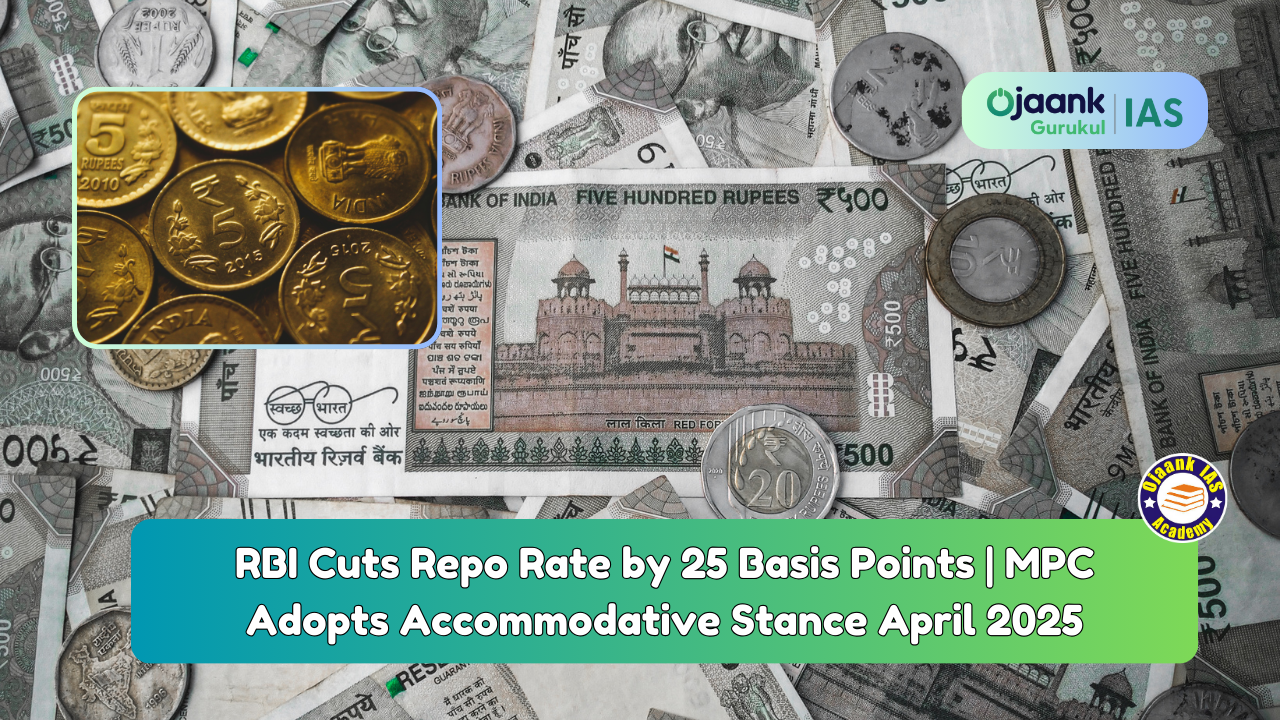RBI Cuts Repo Rate by 25 Basis Points | MPC Adopts Accommodative Stance April 2025

 Key Highlights of the RBI Monetary Policy (April 2025)
Key Highlights of the RBI Monetary Policy (April 2025)
-
Repo Rate: Reduced by 25 bps to 6%
-
Standing Deposit Facility (SDF): Adjusted to 5.75%
-
Policy Stance: Shifted from neutral to accommodative
-
Real GDP Growth Projection (2025-26): 6.5%
-
CPI Inflation Forecast (2025-26): 4.0%
-
RBI Governor: Sanjay Malhotra
 Why the Rate Cut? Understanding the Global Economic Context
Why the Rate Cut? Understanding the Global Economic Context
Announcing the policy decision, RBI Governor Sanjay Malhotra emphasized the growing uncertainty in global trade and policy environments, stating:
“Uncertainty in itself dampens growth by affecting investment and spending decisions of businesses and households.”
He cited several factors for the cautious approach:
-
Trade friction dampening global and domestic growth.
-
Higher tariffs impacting India’s export potential.
-
Complex dynamics around the proposed Foreign Trade Agreement with the USA.
-
Uncertain elasticity of import and export demand.
-
Unclear impact of government policy interventions.
🌐 Explore: India-USA Foreign Trade Agreement – Current Status and Key Issues
Provides deeper insight into the FTA discussions affecting RBI’s cautious stance.
 What This Means for Inflation and Growth
What This Means for Inflation and Growth
Malhotra outlined that inflation risks remain two-sided:
-
On the upside, global uncertainty could trigger currency volatility and imported inflation.
-
On the downside, slower global growth might lead to lower commodity and crude oil prices, helping to ease inflation.
Despite the balancing act, the RBI remains cautiously optimistic, projecting real GDP growth at 6.5% for FY 2025-26 with evenly balanced risks:
| Quarter | GDP Growth Projection |
|---|---|
| Q1 | 6.5% |
| Q2 | 6.7% |
| Q3 | 6.6% |
| Q4 | 6.3% |
🌐 Read: India’s Economic Growth Outlook – IMF Country Report
Enhances understanding of the 6.5% GDP growth projection with international validation.
 Inflation Forecast – CPI at Manageable Levels
Inflation Forecast – CPI at Manageable Levels
Assuming a normal monsoon, CPI inflation for FY 2025-26 is projected at 4.0% with the quarterly breakdown as follows:
| Quarter | CPI Inflation Projection |
|---|---|
| Q1 | 3.6% |
| Q2 | 3.9% |
| Q3 | 3.8% |
| Q4 | 4.4% |
RBI maintains that while vigilance is essential, inflation is not expected to spiral out of control under the current outlook.
🌐 Read: Understanding the CPI: How Inflation is Measured in India
Helps explain what CPI inflation is and how it affects economic stability.
 What’s Next? Hints of More Cuts Ahead
What’s Next? Hints of More Cuts Ahead
With two back-to-back repo rate cuts and a dovish shift in policy stance, Governor Malhotra hinted at the possibility of more easing in the coming months—should global volatility persist and domestic inflation stay under control.
 Impact on Markets, Borrowers & Economy
Impact on Markets, Borrowers & Economy
This policy pivot is likely to have far-reaching implications:
-
Lower interest rates for borrowers, making loans cheaper.
-
Potential boost in consumer spending and investments.
-
Support for small businesses and startups amid capital crunch.
-
Likely market optimism due to RBI’s pro-growth strategy.
🌐 Explore: Monetary Policy vs. Fiscal Policy – What’s the Difference?
Gives clarity on the RBI's role vs. government policy in economic interventions.
 Final Take: RBI’s Balancing Act of Growth & Stability
Final Take: RBI’s Balancing Act of Growth & Stability
The April 2025 monetary policy move underscores RBI's agile response to global headwinds. With inflation reasonably under check and growth facing external pressures, the shift to an accommodative stance reflects a proactive strategy to safeguard India’s economic momentum.
As India steps into a challenging global environment, RBI’s calibrated and data-driven decisions are pivotal in ensuring macroeconomic stability while nurturing domestic growth.
🌐 Explore: RBI Monetary Policy Archive – All Bi-Monthly Announcements
Lets readers compare past RBI decisions and understand evolving strategies.
 Related Resources:
Related Resources:
Stay tuned for updates on the next bi-monthly monetary policy announcement, and follow us for deep-dive analyses on economic trends that matter to your money, market, and future.